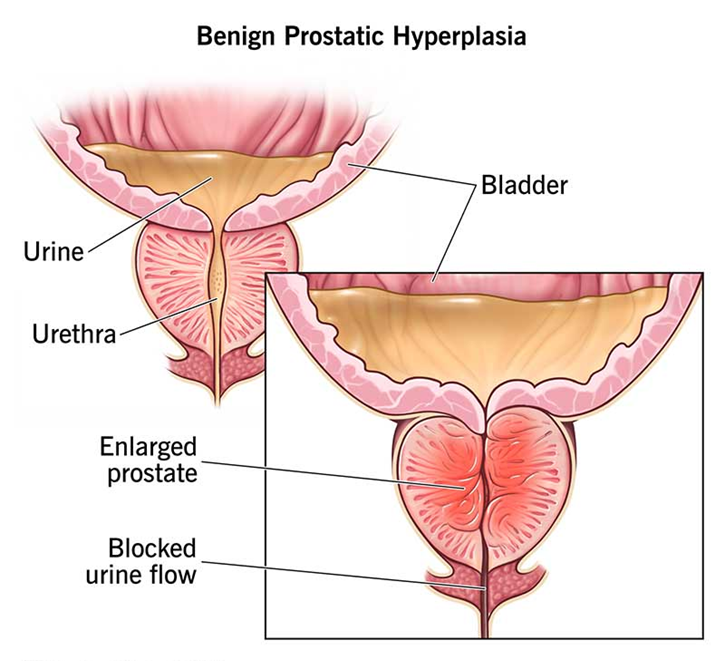A nurse is caring for a client who has benign prostatic hyperplasia (BPH). The nurse should expect which of the following findings?
Painful urination
Urge incontinence
Critically elevated prostate-specific antigen (PSA) level
Difficulty starting the flow of urine
The Correct Answer is D
Choice A: Painful urination
Painful urination, or dysuria, is not a typical symptom of benign prostatic hyperplasia (BPH). BPH primarily affects the flow of urine due to the enlargement of the prostate gland, which can obstruct the urethra. While BPH can cause discomfort, it does not usually result in painful urination. Painful urination is more commonly associated with urinary tract infections (UTIs) or other conditions affecting the urinary tract.
Choice B: Urge incontinence
Urge incontinence, characterized by a sudden and intense urge to urinate followed by involuntary loss of urine, can occur in some cases of BPH but is not the most common symptom. BPH typically causes symptoms related to urinary obstruction, such as difficulty starting urination, weak urine stream, and incomplete bladder emptying. Urge incontinence may develop if the bladder becomes overactive due to the obstruction, but it is not a primary symptom.
Choice C: Critically elevated prostate-specific antigen (PSA) level
While an elevated prostate-specific antigen (PSA) level can be associated with BPH, it is not a definitive finding. PSA levels can be elevated due to various conditions, including prostate cancer, prostatitis, and BPH. However, a critically elevated PSA level is more concerning for prostate cancer rather than BPH. Therefore, while PSA testing is useful in the evaluation of prostate conditions, it is not specific to BPH.
Choice D: Difficulty starting the flow of urine
Difficulty starting the flow of urine, also known as hesitancy, is a hallmark symptom of BPH. The enlarged prostate gland can compress the urethra, making it difficult for urine to pass through. This can lead to a weak urine stream, straining to urinate, and a feeling of incomplete bladder emptying. These symptoms are collectively known as lower urinary tract symptoms (LUTS) and are commonly associated with BPH.

Free Nursing Test Bank
- Free Pharmacology Quiz 1
- Free Medical-Surgical Quiz 2
- Free Fundamentals Quiz 3
- Free Maternal-Newborn Quiz 4
- Free Anatomy and Physiology Quiz 5
- Free Obstetrics and Pediatrics Quiz 6
- Free Fluid and Electrolytes Quiz 7
- Free Community Health Quiz 8
- Free Promoting Health across the Lifespan Quiz 9
- Free Multidimensional Care Quiz 10
View Related questions
Correct Answer is B
Explanation
Choice A reason: Akathisia:
Akathisia is characterized by a feeling of inner restlessness and an inability to stay still. It often manifests as constant movement, such as pacing or fidgeting. While akathisia is a common side effect of antipsychotic medications, it does not typically involve involuntary movements of the tongue and face.
Choice B reason: Tardive dyskinesia:
Tardive dyskinesia is a serious and often irreversible side effect of long-term antipsychotic use, including chlorpromazine. It is characterized by involuntary, repetitive movements, particularly of the face, tongue, and jaw. These movements can include lip smacking, tongue protrusion, and grimacing. This condition is a result of prolonged dopamine receptor blockade in the brain.
Choice C reason: Dystonia:
Dystonia involves sustained muscle contractions that cause twisting and repetitive movements or abnormal postures. It can affect any part of the body, including the neck, face, and limbs. While dystonia can be a side effect of antipsychotic medications, it typically presents as muscle spasms rather than the repetitive, involuntary movements seen in tardive dyskinesia.
Correct Answer is A
Explanation
Choice A: Unlike Chickenpox, the Vesicles of Smallpox Are More Abundant on the Face
This statement indicates an understanding of the teaching. Smallpox lesions are indeed more abundant on the face and extremities compared to chickenpox, which tends to have a more central distribution on the trunk. Smallpox lesions are also typically more uniform in their stage of development, whereas chickenpox lesions can appear in various stages of healing simultaneously.
Choice B: Smallpox Lesions Appear in Various Stages of Healing
This statement is incorrect. Unlike chickenpox, where lesions can be in different stages of healing at the same time, smallpox lesions generally progress through the same stages simultaneously. This uniformity in lesion development is a distinguishing feature of smallpox.
Choice C: Vaccination Against Smallpox Provides Lifelong Immunity
This statement is partially correct but needs clarification. The smallpox vaccine provides long-lasting immunity, but it may not be lifelong. Immunity can wane over time, and booster vaccinations may be necessary for continued protection.
Choice D: There Are Rare, Occasional Occurrences of Smallpox
This statement is incorrect. Smallpox was declared eradicated in 1980 by the World Health Organization (WHO). There have been no naturally occurring cases of smallpox since then. The only known stocks of the virus are kept in secure laboratories for research purposes.
